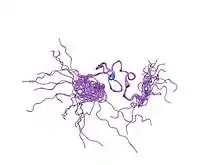AN1 zinc finger
In molecular biology, the AN1-type zinc finger domain, which has a dimetal (zinc)-bound alpha/beta fold. This domain was first identified as a zinc finger at the C terminus of AN1 SWISSPROT, a ubiquitin-like protein in Xenopus laevis.[1] The AN1-type zinc finger contains six conserved cysteines and two histidines that could potentially coordinate 2 zinc atoms.
| zf-AN1 | |||||||||
|---|---|---|---|---|---|---|---|---|---|
 Solution structure of the zf-an1 domain from arabiopsis thaliana f5o11.17 protein | |||||||||
| Identifiers | |||||||||
| Symbol | zf-AN1 | ||||||||
| Pfam | PF01428 | ||||||||
| InterPro | IPR000058 | ||||||||
| SMART | ZnF_AN1 | ||||||||
| |||||||||
Certain stress-associated proteins (SAP) contain AN1 domain, often in combination with A20 zinc finger domains (SAP8) or C2H2 domains (SAP16).[2] For example, the human protein Znf216 has an A20 zinc-finger at the N terminus and an AN1 zinc-finger at the C terminus, acting to negatively regulate the NFkappaB activation pathway and to interact with components of the immune response like RIP, IKKgamma and TRAF6. The interact of Znf216 with IKK-gamma and RIP is mediated by the A20 zinc-finger domain, while its interaction with TRAF6 is mediated by the AN1 zinc-finger domain; therefore, both zinc-finger domains are involved in regulating the immune response.[3] The AN1 zinc finger domain is also found in proteins containing a ubiquitin-like domain, which are involved in the ubiquitination pathway.[1] Proteins containing an AN1-type zinc finger include:
- Ascidian posterior end mark 6 (pem-6) protein .[4]
- Human AWP1 protein (associated with PRK1), which is expressed during early embryogenesis.[5]
- Human immunoglobulin mu binding protein 2 (SMUBP-2), mutations in which cause muscular atrophy with respiratory distress type 1.[6]
AN1-type zinc finger domains are widely present across diverse euryarchaeota and thaumarchaeota, where they are often fused to membrane-associated peptidase domains such as the rhomboid family serine peptidase, transglutaminase-like thiol peptidases of the papain fold, and Zn-dependent metallopeptidases. Archaeal AN1 domains are also linked to transmembrane helices, and domains such as DNAJ and SCP/PR1. These fusions suggest membrane-associated roles for AN1 domain containing proteins in archaea, such as in proteolytic processing of polypeptides and in regulating protein folding or stability. The architectural syntax is remarkably similar to that of the prokaryotic B-box zinc finger and LIM domains.[7]
References
- Linnen JM, Bailey CP, Weeks DL (June 1993). "Two related localized mRNAs from Xenopus laevis encode ubiquitin-like fusion proteins". Gene. 128 (2): 181–8. doi:10.1016/0378-1119(93)90561-G. PMID 8390387.
- Vij S, Tyagi AK (December 2006). "Genome-wide analysis of the stress associated protein (SAP) gene family containing A20/AN1 zinc-finger(s) in rice and their phylogenetic relationship with Arabidopsis". Mol. Genet. Genomics. 276 (6): 565–75. doi:10.1007/s00438-006-0165-1. PMID 17033811. S2CID 31769652.
- Huang J, Teng L, Li L, Liu T, Li L, Chen D, Xu LG, Zhai Z, Shu HB (April 2004). "ZNF216 Is an A20-like and IkappaB kinase gamma-interacting inhibitor of NFkappaB activation". J. Biol. Chem. 279 (16): 16847–53. doi:10.1074/jbc.M309491200. PMID 14754897.
- Satou Y, Satoh N (December 1997). "Posterior end mark 2 (pem-2), pem-4, pem-5, and pem-6: maternal genes with localized mRNA in the ascidian embryo". Dev. Biol. 192 (2): 467–81. doi:10.1006/dbio.1997.8730. PMID 9441682.
- Duan W, Sun B, Li TW, Tan BJ, Lee MK, Teo TS (October 2000). "Cloning and characterization of AWP1, a novel protein that associates with serine/threonine kinase PRK1 in vivo". Gene. 256 (1–2): 113–21. doi:10.1016/S0378-1119(00)00365-6. PMID 11054541.
- Liepinsh E, Leonchiks A, Sharipo A, Guignard L, Otting G (February 2003). "Solution structure of the R3H domain from human Smubp-2". J. Mol. Biol. 326 (1): 217–23. doi:10.1016/S0022-2836(02)01381-5. PMID 12547203.
- Burroughs AM, Iyer LM, Aravind L (July 2011). "Functional diversification of the RING finger and other binuclear treble clef domains in prokaryotes and the early evolution of the ubiquitin system". Mol. Biosyst. 7 (1): 2261–77. doi:10.1039/C1MB05061C. PMC 5938088. PMID 21547297.